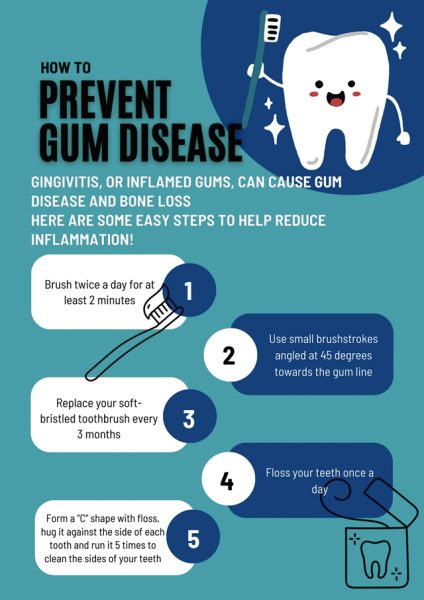
Gingivitis is the term used for inflamed gums, usually resulting in red and puffy gums that may bleed when brushing and flossing. It is important to identify and treat gingivitis, because it can lead to gum disease and bone loss!
Inflammation, such as gingivitis, is the body’s normal response to irritation or injury. Gingivitis is often caused by the presence of dental plaque — that whitish gunk on the surface of teeth before brushing them.
Dental plaque can harden over time and turn into tartar, also known as calculus. Tartar can only be removed by the dentist, so it’s very important to remove plaque before it has the chance to become tartar. Unlike gum disease that comes later, gingivitis is a reversible condition.
By removing the source of inflammation, the gums can heal completely. This is the reason why brushing and flossing your teeth is important as a part of everyone’s oral hygiene.
Although there are many ways to brush your teeth, proper brushing starts with using the right equipment. Electric toothbrushes work well and are the easiest to use, although a manual can work just as well with the correct technique. The brand of toothbrush also doesn’t make much of a difference.
The most important consideration when selecting the size and shape of a toothbrush is to find one that you are comfortable using. Soft bristle brushes work best because they have the flexibility to reach under the gums. Harder bristles can sometimes cause damage to the teeth by wearing them down.
The recommended method is to hold the brush at a 45-degree angle where the gums and teeth meet. This allows the bristles to reach under the gums. Run the toothbrush back and forth along the gumline of each tooth — both the cheek and lips side and then tongue side.
Brush the chewing surfaces of the back teeth. To clean the inside surface of the front teeth, hold the brush vertically and use an up and down motion to clean the area. Do this twice a day, for two minutes each session by breaking up the upper right, upper left, lower left, and lower right into 30-second increments. Switch out toothbrushes for a new one every three months.
Proper brushing only gets you 60 percent of the way to clean, healthy teeth. The remaining 40 percent is through flossing. It is important to floss once every day to clean plaque off in between the teeth. The type and brand of floss doesn’t matter as long as it’s a floss you like and will use.
When flossing, start by taking a piece and wrapping it a few times around one finger on each hand and see-saw it toward the gums and past the point where two teeth are touching. Wrap the floss toward one side of the tooth so the floss makes a “C” shape around it. Run the floss up and down the side of the tooth five times, then wrap the floss around the other tooth and do the same thing. Repeat this process for every spot where two teeth touch.
If an area can’t be flossed, like a bridge or braces, thread the floss with a threader through to the other side and floss that way. Alternatively, some people prefer using proxy brushes or water picks in lieu of floss for these areas. Long-handled reach flossers can also be used as a replacement for using floss on their fingers.
Ask your dentist if you have any questions, and don’t forget:
- Brush twice a day for at least 2 minutes.
- Use small brushstrokes angled at 45 degrees toward the gum line.
- Replace soft-bristle toothbrushes every three months.
- Floss your teeth at least once a day.
- Form a C shape with your floss, hug it against the side of each tooth and run it five times to clean the sides of your teeth.


